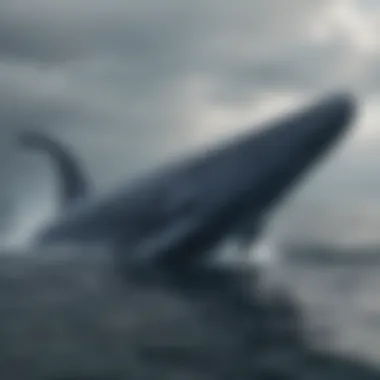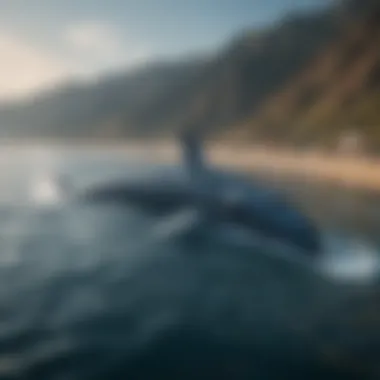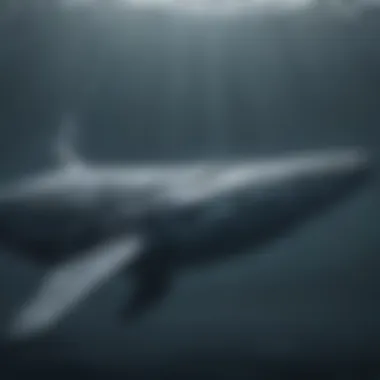Exploring the Blue Whale: Images and Insights into Their Majesty


Intro
The blue whale, scientifically known as Balaenoptera musculus, is the largest animal known to have ever existed on Earth. This magnificent marine mammal captures the imagination due to its sheer size and elegance in the ocean. Among its many features, its heart can weigh as much as a small car, and it can reach lengths of up to 100 feet. Understanding blue whales requires an exploration of their biological characteristics, habitats, and the pressing conservation challenges they face.
Animal Profile
General Overview
Blue whales are categorized as baleen whales, distinguished by their filter-feeding system. They possess a large body with a blue-gray coloration mottled with lighter spots. Adult blue whales can weigh between 100 to 150 tons. Their primary diet consists of tiny shrimp-like animals called krill. An adult blue whale can consume up to 4 tons of krill in a single day during feeding season.
Habitat and Distribution
These whales inhabit all major oceans, although they prefer deeper waters. Blue whales are often found in the North Pacific, North Atlantic, and Southern Oceans. They migrate between their feeding grounds in colder waters and breeding grounds in warmer waters. Understanding their distribution is important for effective conservation efforts.
Fascinating Facts
Unique Traits and Adaptations
Some unique traits of blue whales include their long, streamlined bodies and the ability to dive up to 1,000 feet in search of food. Their call is one of the loudest sounds made by any animal, reaching up to 188 decibels. This communication method is essential for navigation and social interaction within pods.
Historical and Cultural Significance
Historically, blue whales were hunted extensively for their blubber, leading to a significant decline in their population. They are often depicted in literature and art, symbolizing the vastness and mystery of the ocean. Understanding their cultural significance enhances our appreciation for their existence.
Conservation Status
Current Population Trends
The IUCN Red List categorizes blue whales as endangered. Current population estimates suggest that only 10,000 to 25,000 individuals remain today. This decline highlights the need for continued monitoring and conservation efforts.
Threats and Challenges
Blue whales face various threats, including ship strikes, entanglement in fishing gear, and the impacts of climate change. Pollution and noise from human activities also disturb their natural behaviors. Addressing these challenges is critical for preserving their population.
Conservation measures and greater awareness are essential for the survival of blue whales in our oceans.
Care Tips for Pet Owners
Basic Needs and Requirements
While blue whales are not pets, understanding their nutritional needs provides insight into their care in rehabilitation scenarios. A balanced diet composed primarily of krill is vital.
Health and Wellness Tips
Monitoring water quality and ensuring a stress-free environment are crucial for maintaining the health of marine life. It is essential to support organizations dedicated to marine conservation.
Foreword to Blue Whales
Understanding blue whales is essential due to their immense size, unique biology, and the vital role they play in marine ecosystems. In this article, we explore these magnificent creatures, not just through text but with striking visual documentation that encapsulates their grandeur. The blue whale, being the largest animal on the planet, offers insights into the marine world that few species can provide.
The significance of delving into the blue whale's life spans various fields such as marine biology, conservation, and environmental studies. By discussing their biology, habitat, and behavioral patterns, we aim to paint a comprehensive picture of their existence. These insights also underscore the critical need for effective conservation strategies.
Overview of the Species
Blue whales, Balaenoptera musculus, inhabit vast oceanic regions and are known for their sheer size, with adults measuring up to 100 feet in length and weighing as much as 200 tons. Their streamlined bodies and long fins allow them to navigate efficiently through the ocean.
These mammals are defined not only by their size but also by their diet and feeding behaviors. They primarily consume krill, small shrimp-like crustaceans, which they filter through baleen plates. This specialization allows them to thrive in nutrient-rich waters, often playing a key role in the marine food chain.
Furthermore, blue whales are known for their long migration patterns, moving between feeding and breeding grounds. This migratory behavior is vital to their life cycle, allowing them to exploit seasonal abundance in krill populations.


Significance of Visual Documentation
Visual documentation plays a crucial role in the study and appreciation of blue whales. High-quality images and videos encapsulate their size and beauty, drawing public attention to this species. Such visuals can be powerful tools in awareness campaigns, helping to highlight their conservation needs.
Blue Whale Anatomy
Understanding the anatomy of blue whales is vital to appreciate their adaptations and survival strategies. This examination provides crucial insights into how their physical traits influence their behavior, habitat, and overall existence in the marine ecosystem. The three primary aspects to delve into are the physical characteristics, sensory adaptations, and the advantages these elements confer in their natural environment.
Physical Characteristics
Size and Weight
The size of blue whales is remarkable, making them the largest known animals on Earth. Adult blue whales can reach lengths of up to 100 feet and weigh as much as 200 tons. This significant mass and length are crucial for their buoyancy and enable them to traverse vast oceanic expanses efficiently. Their enormous body supports a unique energy conservation strategy, allowing them to maintain minimal movement while traveling long distances. However, such size also presents challenges, like increased energy needs when hunting for food.
Coloration
Blue whales exhibit a distinct coloration that can appear bluish-gray, often mottled with lighter spots. This coloration serves multiple purposes. It provides some level of camouflage in the ocean depths, making it harder for predators or threats to pinpoint them. The unique patterns also aid researchers in identifying individual whales, contributing significantly to ongoing studies. However, the shading can impact heat absorption in varied water temperatures, which is a consideration in their habitats.
Fin Structure
The dorsal fin of a blue whale is relatively small compared to its massive body, typically measuring around one foot in height. This fin plays a crucial role in balance and stability during swimming. The fins, or flippers, are long and slender, aiding in agile maneuvers despite their size. While advantageous for propulsion, this fin configuration could be less effective in turbulent waters, requiring compensatory adaptations in their swimming strategies.
Sensory Adaptations
Vision
Blue whales possess a keen sense of sight, which they rely on during their vast travels and while searching for food. Their eyes are significantly large, helping them detect movement in the water around them. This visual acuity is beneficial for spotting prey and navigating their environment effectively. Nevertheless, they primarily rely on alternative senses when hunting in deep waters, where light is limited.
Hearing
Hearing is perhaps the most critical sensory adaptation for blue whales. Their hearing capabilities are tuned primarily to low-frequency sounds, enabling them to detect vocalizations from miles away. They can communicate over vast distances, which is essential for coordinating social behaviors and finding mates. However, increased noise pollution from shipping and industrial activities threatens their natural communication channels.
Communication
Blue whales utilize a complex system of vocalizations, often referred to as
Habitat and Distribution
Understanding the habitat and distribution of blue whales is essential for grasping their survival strategies and ecological roles within marine ecosystems. Blue whales occupy a vast range of environments throughout the world's oceans, which influences their breeding, feeding, and migratory patterns. Their habitats are characterized by areas rich in krill, their primary food source, and essential for their reproduction and growth. This knowledge not only aids in the study of blue whale behavior but also informs conservation efforts aimed at protecting their natural habitats.
Breeding Grounds
Blue whales typically select specific regions for breeding. These locations are often warmer waters that provide a suitable environment for calves. The calm and nutrient-rich areas allow mothers to nurse their young without substantial disturbances. Breeding grounds are crucial for the continuation of the species. These sites often overlap with migratory routes, meaning that environmental changes in these areas can directly impact population growth and health. Researchers pay close attention to these regions to ensure they remain protected from human activities that could disrupt these vital ecosystems.
Migration Patterns
Migration is an innate behavior of blue whales, influenced by changes in food availability and water temperature. These whales are known for their long-distance migrations, traveling from feeding grounds in colder waters to breeding grounds in warmer regions. This seasonal journey can span thousands of kilometers. The timing of migration can vary depending on the individual whale and local environmental conditions. Understanding these patterns helps scientists predict potential threats during key times of the year, providing vital information for managing blue whale populations.
Global Presence
Blue whales are found in all major oceans; however, their distribution is not uniform. They are more prevalent in certain areas like the North Atlantic and North Pacific, where food sources are abundant. Factors such as water temperature, depth, and food availability dictate their presence in specific regions. Conservationists and biologists monitor these zones closely to manage efforts to sustain populations. Global mapping of blue whale sightings has brought attention to areas that require protection from ship traffic and fishing practices. By understanding the global presence of blue whales, we can better address the challenges they face and work towards conservation strategies that support their long-term survival.
Diet and Feeding Behavior
The section on diet and feeding behavior is crucial for understanding blue whales, the largest animals on the planet. Their feeding mechanisms and dietary preferences play a significant role in their biology and ecology. This knowledge is essential for appreciating their role in marine ecosystems and the threats they face. The survival of blue whales depends directly on their ability to find and consume food efficiently, which affects their health and reproductive success.
Feeding Mechanisms
Blue whales employ unique feeding mechanisms that allow them to consume vast quantities of food. Their primary method is known as lunge feeding. In this technique, a blue whale accelerates toward a patch of prey, opens its mouth wide, and engulfs both water and the small organisms within it. After this, the whale closes its mouth and pushes the water out through its baleen plates, trapping the krill or other food inside.


This feeding technique showcases their physical adaptations. Their bodies are designed for this feeding method, enabling them to take in large volumes of water. Such mechanisms highlight an evolutionary advantage, allowing them to exploit rich feeding grounds effectively.
Primary Diet
Krill Consumption
Krill consumption is a defining characteristic of the blue whale's diet. These small, shrimp-like crustaceans are abundant in the world's oceans, particularly in nutrient-rich waters. Blue whales can consume up to 4 tons of krill daily during feeding seasons.
The abundance of krill is a significant factor contributing to the blue whale's choice of prey. It's advantageous due to its availability in large swarms. Moreover, the high energy content of krill makes it an ideal food source for blue whales, sustaining their massive bodies.
However, relying solely on krill can make these whales vulnerable to changes in the marine ecosystem, such as climate change and overfishing, which may impact krill populations.
Energy Requirements
Energy requirements for blue whales are staggering. Adult blue whales need approximately 1.5 million calories per day, which they obtain primarily through their krill consumption. Their energy needs are tied to their massive size and metabolic rate, necessitating a consistent intake of food.
This high energy need emphasizes the importance of maintaining a stable and plentiful food supply. Changes in their feeding habits can lead to deficiencies in energy intake. Any disruption in krill availability can have dire consequences for their survival.
Understanding the diet and feeding behavior of blue whales helps inform conservation strategies. Protecting their feeding grounds and ensuring healthy krill populations are essential for the future of these majestic creatures.
The blue whale's unique adaptations for feeding highlight the delicate balance of marine ecosystems and the importance of sustainable practices.
Behavioral Patterns
Understanding the behavioral patterns of blue whales is crucial for comprehending their survival strategies and ecosystem roles. These patterns reflect how blue whales interact with their environment and each other. This section will examine key aspects like social organization, communication methods, and parental behaviors, providing a thorough overview of how these majestic creatures navigate their lives in the ocean.
Social Structure
Blue whales, unlike many other marine mammals, do not form stable social groups. They are generally solitary or found in small groups, which often change over time. This flexibility in social structure can be advantageous for their survival. Smaller social groups may reduce competition for food in areas where krill density varies.
In some cases, blue whales can be seen traveling in pairs or groups of three. These temporary associations might help during feeding or migrating. Observations suggest that social interactions are not heavily ritualized but seem to be functional, emphasizing survival over social bonds.
Song and Communication
Communication among blue whales primarily occurs through low-frequency vocalizations, often described as songs. These sounds can travel vast distances underwater, which is essential in the expansive ocean. Song serves multiple purposes: it can facilitate mating, establish territory, or assist in coordinating movements during migration.
Each blue whale may have a unique song pattern, leading to speculation about the cultural significance of these vocalizations among individuals. Some studies suggest that songs may vary by geographic location, indicating that these creatures also possess regional identities.
Conservation Status
Conservation status of blue whales is critical to understanding their future. The gentle giants face multiple threats that need urgent attention. Documenting these threats provides insights needed for effective conservation strategies.
Threats to Population
Whaling History
Whaling has had a significant impact on blue whale populations. Commercial whaling started in the 19th century, targeting these animals for their oil, meat, and blubber. A key characteristic of whaling is its scale; it drastically reduced blue whale numbers, leading to their classification as endangered. This historical context is crucial for understanding their current status. The unique feature of whaling history is the long-lasting effect it has had on the marine ecosystem. The population decline continues to impact breeding rates, making recovery difficult.
Current Threats
Current threats to blue whales are varied and complex. They include ship strikes, climate change, and entanglement in fishing gear. Highlighting these threats emphasizes the urgency of the situation. The main characteristic is the increasing human activity in oceans, which poses risks to whale safety. The unique feature of current threats is their dynamic nature; they can change rapidly due to environmental or political factors. This continues to pose disadvantages for conservation efforts, making effective solutions harder to implement.
Conservation Efforts
International Protections
International protections play a critical role in the conservation of blue whales. Several treaties aim to mitigate the harm these creatures face. A key characteristic is their ability to establish legal frameworks to protect marine life. Implementing these protections is beneficial as they create accountability among nations. However, some unique challenges persist, such as varying levels of enforcement across countries, which can undermine their effectiveness.
Research Initiatives


Research initiatives significantly contribute to understanding blue whale behaviors and ecology. These projects gather critical data about population dynamics and migratory patterns. A key characteristic of research initiatives is their focused collaboration among scientists worldwide. This cooperation enhances the overall knowledge base, leading to better conservation strategies. Moreover, the unique feature of ongoing research is its adaptability; findings often inform new protective measures. However, research limitations exist, primarily due to funding and technological constraints, hindering comprehensive understanding.
The continuous protection and study of blue whales are vital for their survival and for the health of marine ecosystems.
Cultural Representation of Blue Whales
Cultural representation of blue whales highlights their significance beyond mere biological facts. It draws attention to how societies view these magnificent creatures, integrating them into folklore, art, and literature. Understanding cultural aspects helps in recognizing the emotional and societal connections humans share with blue whales, ultimately impacting conservation efforts.
Role in Mythology
Blue whales have appeared in numerous mythologies around the world. They are often portrayed as symbols of strength and mystery. Indigenous peoples of the Pacific Northwest have stories that depict the whale as a transformative being. These narratives create an understanding of the ocean as an interconnected environment, where the blue whale holds a central role in creation stories and moral lessons.
The Maori culture of New Zealand also regards the whale with great reverence. Myths often describe them as guardians of the sea, reminding people of their cultural heritage and bond with the ocean. This role enriches the blue whale's identity, connecting it to human history and culture. These stories elevate the whale beyond its physicality, embodying significant values that resonate with community identity.
Impact on Art and Literature
Blue whales inspire a diverse array of artistic expressions. In painting, they often symbolize the grandeur and fragility of nature. Artists capture their elegance and vulnerability, imploring viewers to reflect on environmental impacts. Notable artists like Winslow Homer have portrayed marine life, setting the stage for discussions around habitat preservation and oceanic health.
Literature has also embraced blue whales, appearing in novels and poetry. For instance, Herman Melville’s Moby-Dick, although primarily about a sperm whale, draws comparisons to the deep oceanic mysteries that blue whales represent. Such works prompt questions about humanity's relationship with nature, emphasizing themes of coexistence and respect.
Moreover, modern writers tackle contemporary issues. The blue whale serves as a metaphor for conservation struggles. Authors have stressed the need for awareness, linking the creature's survival to broader ecological circles.
The Future of Blue Whales
The blue whale, the largest animal on earth, faces significant challenges that threaten its future. Understanding these challenges is crucial not only for the species itself but also for the broader marine ecosystem. Protecting blue whales ensures the health of oceanic environments, as their behaviors and migratory patterns influence various marine species.
Conservation measures are imperative and require collaboration among governments, researchers, and the public. Awareness of these magnificent creatures is a step toward fostering communities passionate about marine conservation.
Ongoing Research
Ongoing research plays a pivotal role in shaping the future of blue whales. Scientists are studying their populations, migratory routes, and socioecological impacts. This research is fundamental to understanding the challenges these creatures face, such as climate change, ship traffic, and entanglement in fishing gear.
Recent studies have utilized advanced technology, such as satellite tagging and aerial surveys, to monitor blue whale behavior and population dynamics. Data from these studies inform conservation strategies and policies, making them essential tools for protection efforts. Consider the following areas of focus in blue whale research:
- Population Recovery: Tracking population numbers to understand recovery trends and reproductive rates.
- Habitat Use: Identifying critical habitats that need protection from human activities.
- Behavioral Studies: Investigating how whales respond to environmental changes and human impacts.
Continued funding and support for research initiatives ensure that scientists can keep advancing our knowledge.
Public Awareness and Engagement
Public awareness is vital for the conservation of blue whales. Engaging communities and individuals in the plight of these animals fosters a sense of stewardship. Social media campaigns, documentaries, and educational workshops are effective tools in raising awareness.
Understanding the importance of blue whales can lead to actions such as:
- Supporting Legislation: Advocating for laws that protect marine life and habitats.
- Join Citizen Science Projects: Getting involved in local efforts to monitor whale populations or reducing plastic waste in oceans.
- Participating in Beach Cleanups: Helping maintain cleaner ocean environments that support marine biodiversity.
Public interest can also drive participation in conservation endeavors and encourage businesses to adopt sustainable practices. Together, proactive efforts by the public, scientists, and policymakers can shape a brighter future for blue whales and the oceans they inhabit.
"Conservation of blue whales is not just about saving a species; it's protecting a vital component of ocean health."
Finale
The conclusion section holds significant importance in this article. It serves as the final opportunity to summarize the complex details discussed and to reinforce the critical aspects of blue whale biology and conservation. Understanding blue whales enriches not only our knowledge of marine life but also emphasizes the necessity of protecting these gentle giants and their habitats.
Synthesis of Key Points
In our exploration of blue whales, several key points emerge:
- Overview of Blue Whales: The largest animals on Earth, known for their immense size and grace.
- Anatomy: Unique physical and sensory adaptations that allow them to thrive in various oceanic environments.
- Feeding Behavior: Specialized feeding mechanisms that enable them to consume vast amounts of krill.
- Behavioral Insights: Complex social structures and communication methods, including their haunting songs.
- Conservation Status: A pressing need for conservation efforts due to historical whaling and ongoing threats to their populations.
- Cultural Representation: Their impact on human culture through mythology, art, and literature highlights our connection to these magnificent creatures.
- Future Outlook: The continuous research and public engagement are crucial for ensuring their survival.
Call to Action for Conservation
This article stands as a call to action, urging readers to recognize their role in blue whale conservation. Engaging in conservation efforts can take various forms:
- Awareness Campaigns: Educating others about the threats blue whales face, including pollution and climate change.
- Support Conservation Organizations: Partnering with groups dedicated to protecting marine life, such as the Whale and Dolphin Conservation or the Ocean Conservancy.
- Responsible Tourism: Participating in eco-friendly whale watching initiatives that promote respect for these animals and their natural habitats.
- Advocating for Legislation: Supporting policies aimed at preserving ocean ecosystems and reducing human impact.
By fostering a collective responsibility towards blue whales, we enhance their chances of survival. Every action counts in the journey towards a healthier ocean and a future where these majestic beings can continue to roam freely.















